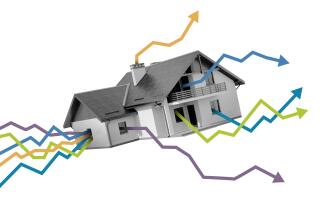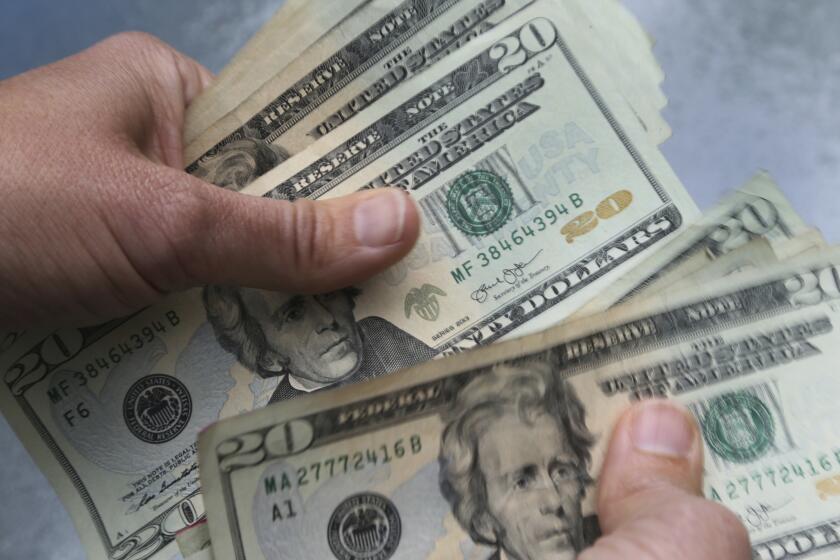Housing Stuck in 2nd Gear : Lower Home Rates but No Building Boom
- Share via
Strange things happened in the U.S. housing market last year when mortgage rates fell to their lowest level of the decade.
Construction of new homes went down, and average monthly payments on new mortgages went up--the opposite of what logic would dictate.
But these patterns merely reflect some of the powerful changes blowing through the nation’s housing industry that have partially negated the impact of dropping interest rates. Today’s home market is getting buffeted from so many directions, analysts say, that lower mortgage rates no longer automatically mean happy times for home builders or buyers.
The enactment of tougher lending standards, for example, will prevent millions of consumers from getting mortgage loans this year, according to a report from Dallas-based Lomas & Nettleton, a major mortgage banking firm.
Although the nation’s housing industry is hardly in a slump, the boom times expected when mortgage rates fell below 13% have yet to materialize. Fixed mortgage rates have fallen to as low as 11% or less after averaging about 12.25% in 1985 and nearly 14% in 1984.
“Where is the loan demand everyone thought was forthcoming?” asked one economist at a large savings and loan association in Southern California.
The result has been disappointment in some segments of the housing industry, particularly among builders.
“The biggest surprise of 1985 is that we haven’t done better,” said Michael Sumichrast, chief economist for the National Assn. of Home Builders. “We’ve done all right, but that’s about it.”
Construction of new homes--referred to in industry argot as housing starts--fell to 1.73 million units in 1985, from 1.75 million the year before, principally because builders did not anticipate that rates would drop so sharply, analysts said. Some mortgage rates fell a full percentage point in the last three months of the year.
“The starts didn’t go up because builders were pessimistic,” said Thomas Lawler, senior financial economist for the Federal National Mortgage Assn, the quasi-governmental agency known as Fannie Mae. “They didn’t realize rates would continue dropping.”
Economists and lenders pay close attention to housing starts because of their broad impact on the economy. The construction of 100,000 single-family homes will generate an immediate $3.25 billion in wages and $1.5 billion in various federal, state and local taxes, the National Assn. of Home Builders estimated.
Sales Are Healthy
Home sales, on the other hand, have been healthy--if unspectacular--in most regions of the country, including California where the sale of existing homes surpassed 400,000 last year, up 6.3% from 1984.
Existing home sales nationwide are expected to reach 3.2 million units in 1985, up 11% from 1984 levels, while sales of new single-family homes will hit 681,000, a gain of 6.6% from the year before, according to industry estimates.
But housing analysts say most of the sales strength stems from the Northeast, where a booming regional economy has catapulted real estate values to among the highest in the nation. Elsewhere, no one in the business appears to be doing any handstands of happiness.
“There are lots of homes for sale out there,” said Walter Keusder, a builder from Orange County and former president of the California Building Industry Assn. “In the aggregate the figures look good, but nobody is going great guns.”
(California’s housing starts were up a healthy 18% to 251,400 units last year.)
In this new housing environment, demand throughout most of the nation has been shrinking for several reasons.
Speculation Fading
Speculation, which played a key role in California’s land boom of the late 1970s, has all but disappeared because real estate values have not kept up with inflation. That means that most buyers today seek homes as shelter, not as investments to be sold when the price is right.
“People tend to be buying homes for the right reason,” Walter Klein, senior executive vice president of Lomas & Nettleton, said. “They want to live in them.”
In California, the average price of existing homes rose to $118,800 in 1985, a 5.6% increase over 1984. That was the first time in five years that housing prices have outpaced inflation, according to the California Assn. of Realtors.
“By the 1990s, housing as an investment will be all but forgotten,” said Robert Gough, housing economist for Data Resources in Lexington, Mass. “That investment in residential real estate was a phenomenon of the late 1970s and early 1980s.”
Demand has also been shrinking because bankers are tightening lending standards to head off growing foreclosure problems that are particularly evident in such cities as Houston, where dropping oil prices have played havoc with the local economy.
Today, private mortgage insurers are reluctant to insure any loan with less than a 10% down payment, while the Federal National Mortgage Assn. generally will not buy loans where mortgage payments exceed 25% of borrowers’ income. The limit had been 28% until last summer.
Negated Benefits
The Fannie Mae move has had a major impact because the quasi-government agency, which provides a huge secondary market for mortgage loans, helps set the standard for the home-loan industry. Some housing economists think that the tougher requirements have negated most of the benefits of dropping interest rates because they make mortgage loans less affordable.
The graying of the baby boom generation--that group born in the decade and a half following World War II--also means that fewer first-time home buyers in their early 20s are entering the market.
“The baby boom, which fueled so much of the housing demand of the past 15 years, is busting out,” Lomas & Nettleton said in another housing report published in November.
“The demographics have changed,” housing analyst Gough said. “We’re on the back side of baby boom. There’s not much pent-up demand left out there. It has all been satisfied.”
The American public is also supporting record-high levels of debt, which is not helping the housing market much either, analysts say. “The consumer is up to his eyeballs in debt,” said A. Gary Shilling, a New York-based economics consultant.
According to Lomas & Nettleton, average mortgage payments rose to $865 a month last year, up 2.4% from 1984, despite the lower interest rates. That anomaly resulted because buyers bought more expensive homes. “When rates dropped last year, the customer opted for more house instead of lower payments,” Lomas & Nettleton said.
Changing Expectations
The changing demand has meant changing expectations about what makes a healthy housing market. “Housing starts of 1.7 million or 1.8 million are now considered a good year,” Gough said. “It used to be that 2 million units was a good year.”
There are also sharp regional differences in the nation’s housing economy that have divided the industry as never before.
Although housing is booming in New England, where the local economy is thriving because of its high-tech personality, activity is foundering in such states as Texas, Oklahoma and Louisiana, which are reeling from the shocks of lower crude oil prices.
Home prices in Boston and New York increased so much in 1984 and 1985 that they now rank among the highest in the nation, higher even than in most of Southern California. But in Texas, housing starts in 1985 were running about one-third below 1984 levels, according to Real Estate Research Institute at Texas A&M; University.
“I don’t ever remember seeing such major regional differences as there are today,” economist Sumichrast, of the national builders association, said.
Good Time to Buy
Most lenders and economists agree that 1986 should be an excellent time to get a fixed-rate mortgage because interest rates appear to be nearing--or have already hit--bottom. That is, if consumers can qualify for the loans.
“1986 could be the lowest year for mortgage rates for the next two or three years,” Gough said. And Bank of America housing economist Michael Salkin said, “It’s a buyer’s market all the way.”
Single-digit fixed mortgage rates, which fueled the post-World War II housing boom and were a fixture in America until 1978, will reappear only if there is a recession, most experts believe.
“We’ve not rooting for single-digit interest rates,” Roger Lister, housing analyst for Chase Econometrics, said. “We think the 10s is reasonable. We think we’ve seen the bottom.”
More to Read
Inside the business of entertainment
The Wide Shot brings you news, analysis and insights on everything from streaming wars to production — and what it all means for the future.
You may occasionally receive promotional content from the Los Angeles Times.










